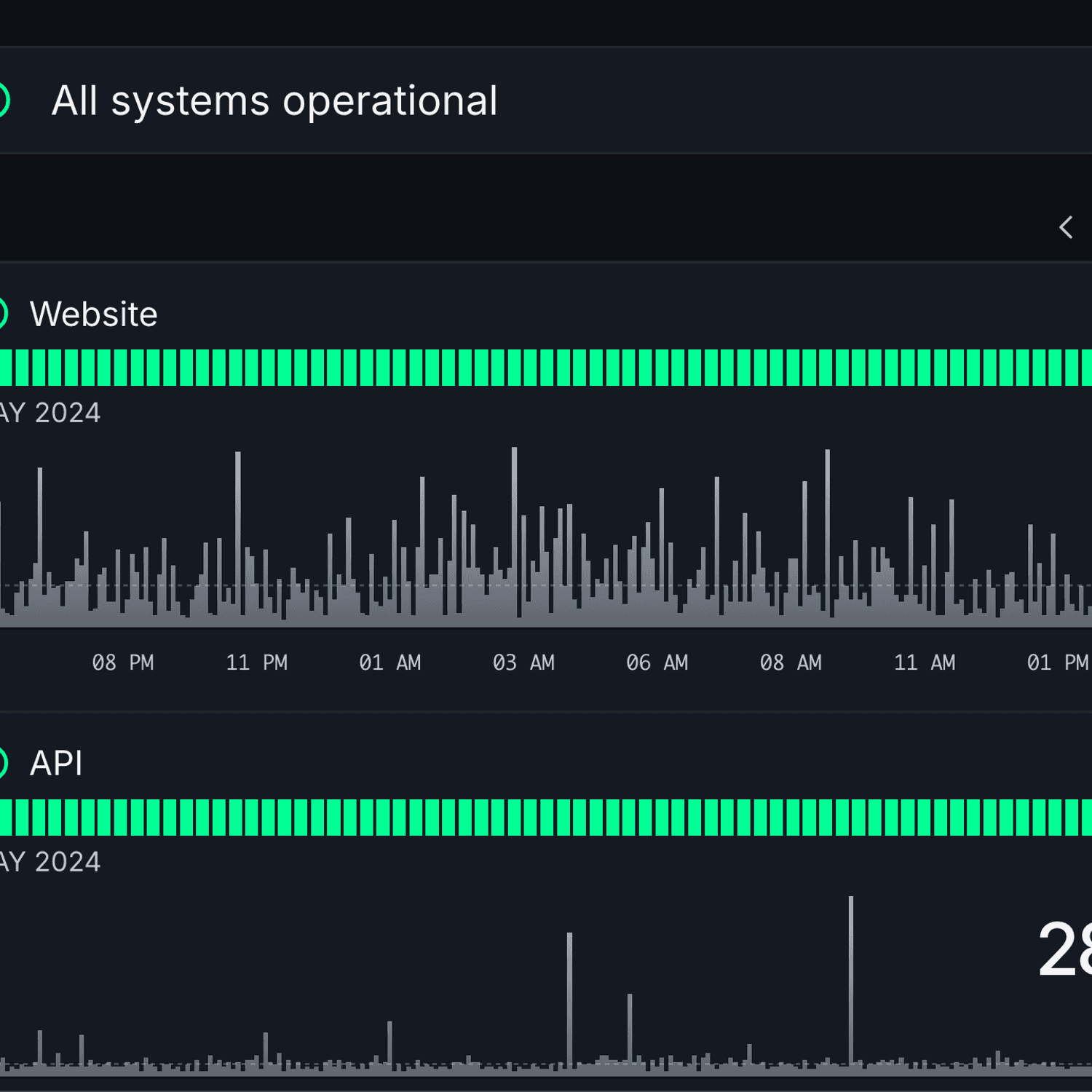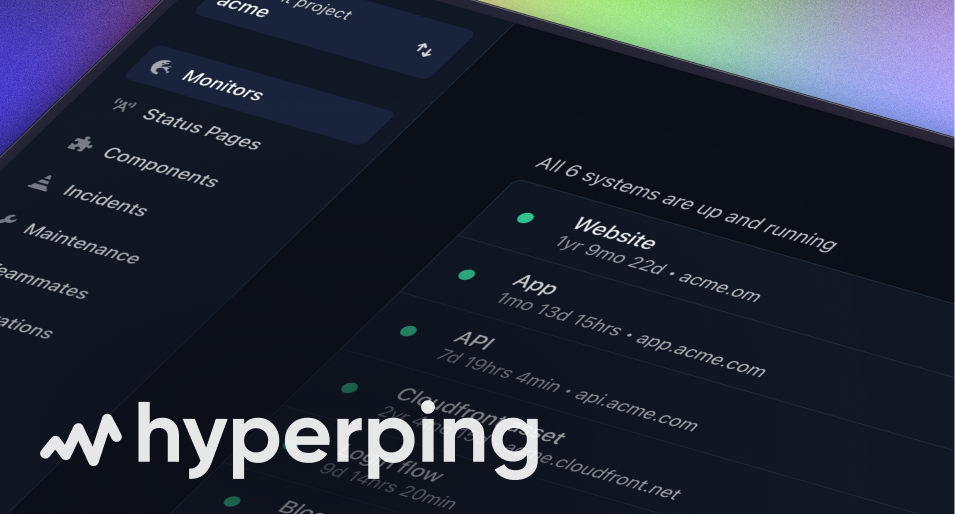PagerDuty, Splunk, ServiceNow — with dozens of incident management tools on the market, how do you know which one to choose?
Here's the reality — downtime costs organizations an average of $9,000 per minute. That's why companies are increasingly investing in incident management tools to reduce disruption and improve their incident response.
But with the market evolving rapidly and new players emerging constantly, selecting the right tool has become more challenging than ever.
For this guide, we analyzed over 45 incident management tools to help you find the perfect solution for your needs.
We'll break down their key features, pricing, and ideal use cases to help you make an informed decision. Whether you're looking for AI-powered automation, enterprise-grade features, or a cost-effective solution for a growing team, you'll find options that match your requirements.
Types of incident management tools
First, let's explore the different types of tools that you need.
Incident management tools can be categorized into several types based on their primary functions and focus areas:
Core incident response tools
These tools focus on the immediate handling and resolution of incidents:
- Incident response platforms
- Alert management systems
- On-call management tools
- Status page platforms
Examples include:
- Hyperping
- PagerDuty
- FireHydrant
Core incident response tools help teams detect, triage, and resolve incidents quickly while keeping stakeholders informed.
Communication and collaboration tools
These tools facilitate communication and knowledge sharing during incidents:
- Internal communication platforms
- Team chat applications
- Knowledge management systems
- Documentation tools
Examples include:
- Slack
- Notion
- Internal wikis
Communication tools ensure teams can coordinate effectively and maintain institutional knowledge about incident handling.
Support and service desk tools
These tools handle the customer-facing aspects of incident management:
- Help desk software
- Ticket management systems
- Customer service platforms
- Self-service portals
Examples include:
- Zendesk
- Freshservice
- ServiceNow
Support tools help teams track and resolve customer-reported issues while maintaining clear communication.
Security incident response tools
These specialized tools focus on security-related incidents:
- Security information and event management (SIEM)
- Threat detection systems
- Security orchestration and response
- Compliance management
Examples include:
- Splunk
- IBM QRadar
- Rapid7
Security tools help teams identify, contain, and remediate security breaches and vulnerabilities.
Analytics and improvement tools
These tools provide insights to help prevent future incidents:
- Incident analytics platforms
- Performance monitoring
- Root cause analysis
- Reporting dashboards
Examples include:
- xMatters
- New Relic
- Datadog
Analytics tools help teams understand incident patterns and make data-driven improvements to their incident response processes.
Project management tools
These tools help coordinate larger incident response initiatives:
- Project tracking
- Resource management
- Timeline planning
- Task assignment
Examples include:
- Jira
- ClickUp
- Monday.com
Project management tools help teams organize complex incident response workflows and track progress across multiple initiatives.
Summary: Our top picks for incident management tools in 2025
We wanted to focus our software highlights on tools best fitted for growing startups, and we decided to pick 3 tools over the 45 platforms we analyzed.
| Name | Why we picked it | Free version? | Pricing |
|---|---|---|---|
| Hyperping | Best for startups needing integrated monitoring and status pages. Simple setup with powerful automation. | 5 monitors, 1 basic status page | From $24/mo for 50 monitors and full features |
| Incident.io | Best for Slack-native incident response with excellent automation. | Available for small teams | From $15/user/mo |
| xMatters | Best for teams wanting deep incident analytics and ML-powered insights. | Up to 10 users | From $9/user/mo |
Open-source incident management tool pick
If you're looking for an open-source solution, Dispatch by Netflix stands out as the most capable option. It offers comprehensive incident orchestration while leveraging your existing tools, making it ideal for teams that want control over their incident management stack without starting from scratch.
Other open-source alternatives include GoAlert, and AlertManager, but they tend to be more specialized or require significant setup effort.
What about the other incident management tools?
While we couldn't detail every tool, here's a quick breakdown of alternatives we dismissed:
- Too expensive for most startups — ServiceNow, BMC Helix ITSM, Splunk, AppDynamics, Dynatrace
- Limited functionality — SpiceWorks Help Desk, Mantis Bug Tracker, Uptime Robot, Rundeck
- Requires extensive setup — Zabbix, Prometheus, AlertManager, Grafana
We also didn't think it was relevant to make a guide on knowledge management tools and the less technical tools, so if that's what you're looking for, here are a few links for you:
- Best help desk tools on G2
- Knowledge management software on G2
- Internal communication tools on G2
- Top project management platforms on G2
Best tools by use case
Based on our analysis, here are our top picks for specific needs:
- Enterprise & large teams — PagerDuty, ServiceNow
- Growing startups — Hyperping, incident.io, FireHydrant
- DevOps-focused teams — Better Stack, Squadcast, Grafana OnCall
- Security incidents — Splunk, ComplianceQuest, BigPanda
- Budget-conscious teams — Instatus, Freshservice, AlertOps
Hyperping: Best for integrated status pages & incident management
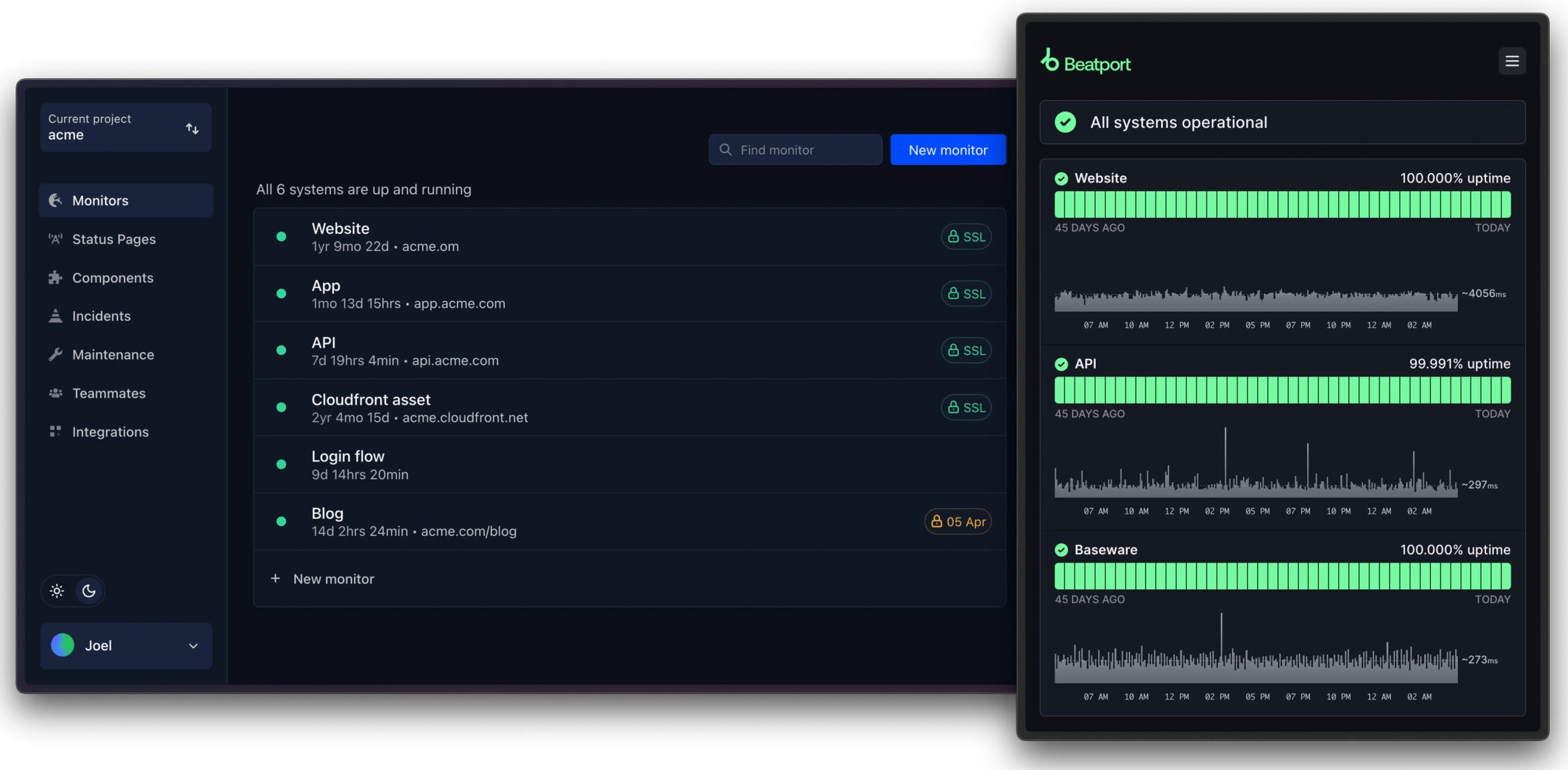
Hyperping is an all-in-one solution that provides beautiful and intuitive status pages with built-in monitoring with advanced tooling such as HTTP, ICMP or Cron job, that makes real-time updates flawless between your monitors and your status pages.
Main benefits
- Built-in uptime monitoring
- Static status pages for instant loading
- Publish incident updates
- Scheduled maintenance
- Integrations such as PagerDuty, Teams, Slack
- Works great for multi-tenancy
Pricing
- 1 free basic status page.
- $24/mo for 50 monitors, 2 users, 1 full-featured status page, and more.
- Unlimited private and public full-featured pages for $74/mo. Also includes 6 users, 100 monitors, and more.
Compare Hyperping with other status page & uptime monitoring tools
Incident.io — Best on-call management software
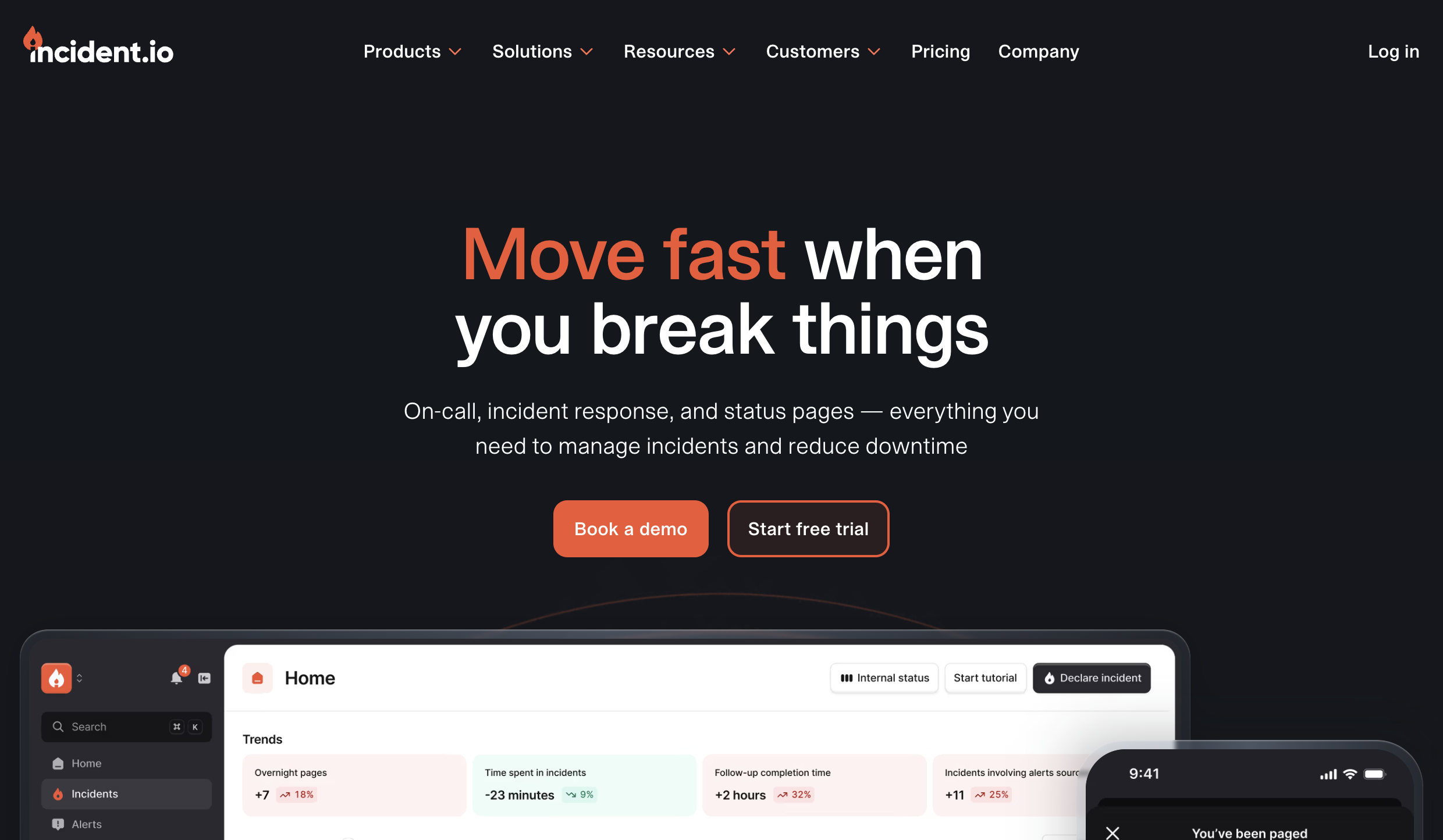
Incident.io helps you manage incidents directly in Slack, automating everything from initial response to post-mortems. Like a skilled conductor, it orchestrates your incident response by bringing the right people and information together instantly.
Key features
- Slack-native incident management
- Automated incident workflows
- Real-time incident timelines
- Post-mortem templates
- Custom incident roles
- Automatic stakeholder updates
Pros
- Seamless integration for Slack
- Quick setup time
- Automated workflow creation
- Real-time collaboration tools
- Built-in post-mortem process
Cons
- Requires Slack (or Teams)
- Limited integrations compared to alternatives
- Advanced features only in higher tiers
- Can be expensive for larger teams
xMatters — Best incident analytics software
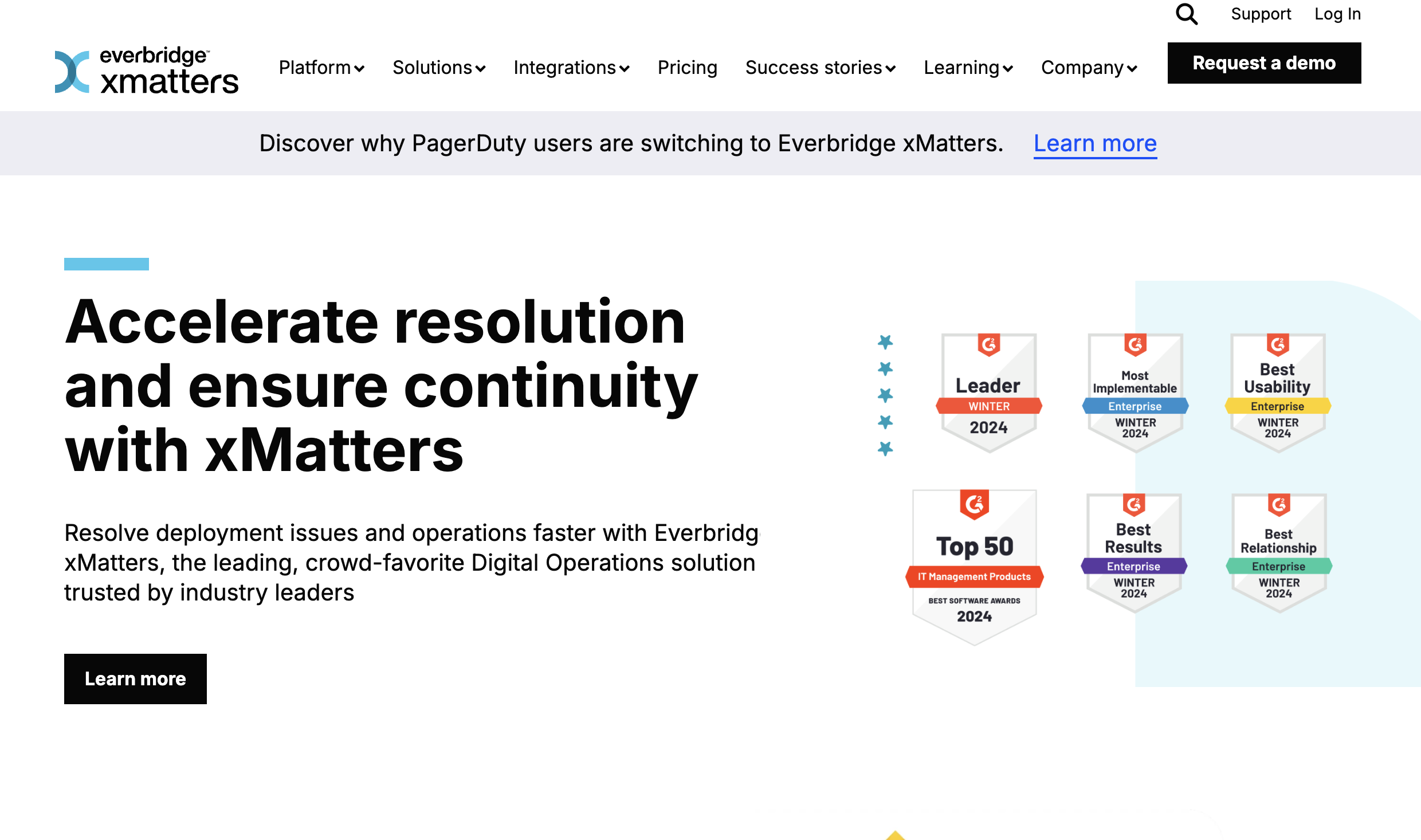
When incidents hit, you need more than just alerts — you need deep insights to prevent future problems. xMatters delivers powerful analytics that help teams understand incident patterns and optimize response times.
Key features
- Signal intelligence for automated incident routing
- Live incident timeline tracking
- Detailed analytics on response times and patterns
- Adaptive incident management with ML
- Multi-language support for global teams
Pros
- Advanced analytics reveal incident trends and bottlenecks
- Flexible roles and permissions for enterprise teams
- Multilingual messaging for global organizations
- Mobile apps enable on-the-go incident management
- Integrates with major DevOps and IT tools
Cons
- Interface needs modernization
- Steep learning curve for advanced features
Pricing
- Free tier supports up to 10 users
- Starter plan at $9/user/month
- Base plan at $39/user/month
- Advanced plan pricing available on request
Benefits of incident management tools
- Real-time incident tracking — These tools give you instant visibility into what's happening, who's working on it, and how close you are to resolution. No more wondering if that critical issue is being handled.
- Automated workflow magic — Say goodbye to manual ticket routing and endless email chains. Modern incident tools automatically assign issues to the right people, trigger notifications, and kick off response workflows. Your team can focus on fixing problems instead of juggling administrative tasks.
- Smarter communication — When incidents strike, clear communication is everything. These tools create dedicated channels for incident updates, automatically notify stakeholders, and maintain a single source of truth. Everyone stays in sync without the chaos of scattered messages.
- Faster problem-solving — Incident management tools help you identify and resolve issues faster with features like automated alerting, incident prioritization, and easy access to runbooks and documentation. The result? Less downtime and happier customers.
- Data-driven improvements — These tools give you detailed incident analytics and post-mortems, helping you spot patterns and prevent future problems. You'll build a more reliable system based on real data, not guesswork.
- Enhanced collaboration — Modern incident tools break down silos between teams. Whether it's DevOps, IT, or customer support, everyone works from the same playbook with shared visibility and standardized processes. This means faster resolutions and fewer dropped balls.
Common mistakes when choosing incident management tools
Selecting incident management software isn't rocket science, but there are several pitfalls that teams frequently stumble into. Let me walk you through the most common mistakes I see organizations make, and more importantly, how to avoid them.
1. Not assessing team requirements first
Starting your search without understanding what your team actually needs is a recipe for disappointment. Different teams have different incident complexities and collaboration needs.
How to avoid it:
- Document your current incident response workflows
- Get input from team members who'll use the tool daily
- Consider your incident volume and complexity requirements
- Map out must-have versus nice-to-have features
2. Overlooking integration capabilities
Your incident management tool needs to work seamlessly with your existing tech stack. Otherwise, you're creating more manual work and potential communication gaps.
How to avoid it:
- List all the tools your team currently uses
- Verify compatibility with your monitoring systems
- Check if it works with your communication tools (Slack, Teams, etc.)
- Ensure it supports your preferred notification channels
3. Ignoring automation features
Many teams focus on basic features while overlooking automation capabilities that could save hours of manual work.
How to avoid it:
- Look for automated incident creation and routing
- Check for automated escalation capabilities
- Verify if it can automate status updates
- Ensure it supports workflow automation
4. Forgetting about scalability
Your incident response needs will grow with your organization. A tool that barely meets your current needs will become a bottleneck surprisingly fast.
How to avoid it:
- Check performance with larger incident volumes
- Verify user and data scaling capabilities
- Consider future integration needs
- Look at pricing for scaled usage
5. Choosing overly complex solutions
Sometimes teams pick tools with every feature under the sun, only to find that complexity hurts adoption and efficiency.
How to avoid it:
- Prioritize user-friendly interfaces
- Look for tools with minimal learning curves
- Test the tool with actual team members
- Consider the training requirements
6. Neglecting reporting capabilities
Without proper analytics and reporting features, you'll struggle to improve your incident response process over time.
How to avoid it:
- Check what metrics the tool can track
- Verify customizable reporting options
- Ensure it supports post-incident reviews
- Look for trend analysis capabilities
7. Underestimating support needs
Even the best tool can become a headache without proper vendor support and resources.
How to avoid it:
- Research the vendor's support options
- Check response times for critical issues
- Look for training resources and documentation
- Verify the availability of technical support
How to choose the right incident management tools
The reality is that the "best" incident management tool depends entirely on your specific needs. What works perfectly for a large enterprise might be overkill for a startup. And what's ideal for a tech-savvy team might be too complex for others.
Let's break down exactly what you need to consider when choosing an incident management tool, helping you make an informed decision that aligns with your team's requirements.
Essential features to look for
When evaluating incident management solutions, certain features can make or break their effectiveness. Here are the key capabilities to consider:
- Alert management and routing — Smart filtering and prioritization of alerts to reduce noise and fatigue
- Real-time collaboration — Built-in tools for team communication during incidents
- Automation capabilities — Automated workflows for faster incident response
- Integration flexibility — Ability to connect with your existing tech stack
- Customizable workflows — Freedom to adapt processes to your team's needs
- Analytics and reporting — Tools to measure MTTR and other key metrics
- Mobile support — Access to critical features on the go
Business requirements to consider
Your business context plays a crucial role in choosing the right solution. Consider these factors:
- Scalability needs — How the tool will grow with your organization
- Team size and structure — Number of users and their roles
- Budget constraints — Total cost including implementation and training
- Compliance requirements — Any specific regulatory needs
- Support availability — Level of vendor support offered
- Implementation timeline — How quickly you need to get up and running
Technical considerations
Don't overlook the technical aspects that ensure reliable incident management:
- Deployment options — Cloud-based vs self-hosted solutions
- Security features — Access controls and data protection
- API availability — Capabilities for custom integrations
- Performance under load — How the tool handles high-volume incidents
- Data retention — Storage capabilities for historical incident data
- Backup and redundancy — Reliability during system outages
Improve your incident response process with Hyperping
Hyperping is the perfect incident management tool for organizations looking to break down tool silos and improve incident response times.
Hyperping's unified dashboard offers a single place for teams to monitor their IT environment, manage their status pages, and survey their services. Real-time alerts and automated workflows help teams triage incidents quickly, reducing Mean Time To Resolution (MTTR).
If you're ready to take your incident management to the next level, sign up for Hyperping today!



